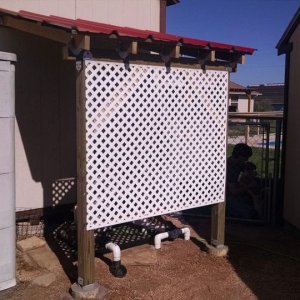- May 23, 2015
- 25,667
- Pool Size
- 16000
- Surface
- Plaster
- Chlorine
- Salt Water Generator
- SWG Type
- Pentair Intellichlor IC-60
So the other day I was out at the equipment pad and I happened to notice the dirt looked a little different under the plumbing where the two return-side diverter valves are (one of the benefits of living in a desert is that we don’t have grass to mask all our water leak problems). So I threw the switches on the CVA actuators and, low and behold, when the valve shaft would turn, a little squirt of water would come out. I won’t go into the details of my return-side plumbing but, suffice it to say, there are two diverter valves (Pentair 2” 3-way valves) there.
Now there are plenty of videos online for how to fix a diverter but I wanted to show the source of the leak in the shaft seal because it’s probably the most common form of leak given that the shaft is where all the action is in the valve. The two pictures below show the diverter door and then a close up the shaft -
So you can see in the second picture the diverter door shaft with the two o-rings and the plastic split-ring in the middle. The seal is created by the two o-rings - the one on the right mates to the upper surface of the valve cover and the one on the left mates to the bottom of the diverter shaft. There is a split plastic ring in the middle that allows the two o-rings to rotate independently of one another when the shaft turns. Over time those o-rings eventually wear out and you’ll get a leak. Those o-rings were over 6 years old so that’s a pretty good service life given how often (daily) those valves are actuated.
The fix is cheap. You can either but a pack of o-rings for the valve that has enough to service 12 valves and the split ring for less than $15 on Amazon OR you can buy a new diverter door (with o-rings and split ring already there) for around $30. Sometimes the door seal wears out or gets torn up so it helps to replace the entire door if you see it’s not in good shape. The fix takes all of 15mins and 8 screws to do. Just make sure you note the alignment of the door relative to the handle position so that everything turns the way it’s supposed to.
Now there are plenty of videos online for how to fix a diverter but I wanted to show the source of the leak in the shaft seal because it’s probably the most common form of leak given that the shaft is where all the action is in the valve. The two pictures below show the diverter door and then a close up the shaft -
309FB8E5-AB39-40C6-B462-49FA56C5A9BF.jpeg
Diverter valve shaft with o-rings and split ring
So you can see in the second picture the diverter door shaft with the two o-rings and the plastic split-ring in the middle. The seal is created by the two o-rings - the one on the right mates to the upper surface of the valve cover and the one on the left mates to the bottom of the diverter shaft. There is a split plastic ring in the middle that allows the two o-rings to rotate independently of one another when the shaft turns. Over time those o-rings eventually wear out and you’ll get a leak. Those o-rings were over 6 years old so that’s a pretty good service life given how often (daily) those valves are actuated.
The fix is cheap. You can either but a pack of o-rings for the valve that has enough to service 12 valves and the split ring for less than $15 on Amazon OR you can buy a new diverter door (with o-rings and split ring already there) for around $30. Sometimes the door seal wears out or gets torn up so it helps to replace the entire door if you see it’s not in good shape. The fix takes all of 15mins and 8 screws to do. Just make sure you note the alignment of the door relative to the handle position so that everything turns the way it’s supposed to.










